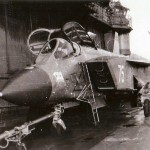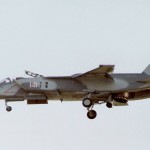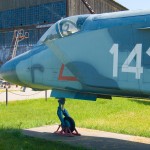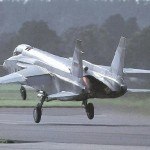
Yakovlev never thought it had a lasting fighter aircraft in its Yak-38, the Soviet Union’s first fixed-wing carrier jet and the only production Soviet VTOL aircraft. Soviet aircraft carriers were much different than the massive American supercarriers we’re used to seeing. The vertical take-off and landing capable Yaks were the only fighters the Soviets could carry. And the Yak-38 was slow, poorly armed, and weak.
But Yakovlev learned a lot from the 38. STOVL/VTOL aircraft were, and remain to this day, all the rage with the western “Harrier” family and the F-35 “Lightning II.” Yakovlev just didn’t know the role it would come to play in this field until later.
In the 1980s, the Soviets were hungry for a versatile carrier jet, one that could go beyond the role of simple interception and fleet defense. The next Yak would be able to sustain supersonic speeds and feature a variety of armament.
The superpower spared no expense at the time. Alexander Sergeyevich Yakovlev put at least 10 of his chief designers on what the military had originally called the Yak-41. More than 50 designs would be looked at before the team set its sights on a single-engine design with a vectoring nozzle and thrust jets behind the cockpit. The extreme temperatures that came with thrust vectoring and VTOL meant the plane had to be built with materials that could stack up, so titanium, graphite, and composites were chosen. Even so, the plane was not meant to hover for more than 2.5 minutes because of overheating worries.
The plane was designed to carry modern avionics and systems, including doppler radar, laser and TV guidance, a HUD, and helmet-mounted missile arming that let the pilot target an enemy up to 80 degrees to the right or left. The pilot could not see behind him, however.
Four prototypes were funded, and the Yak-41 made its first flight in 1987 at Zhukovskii. Two years later, the first successful hover flight test took place. The Soviets used the Yak-141 designation to throw off observers, as the program was classified a the time. In September 1991, the first successful vertical landing on a Soviet aircraft carrier took place. The Yak-41 would become the first VSTOL aircraft to achieve sustained supersonic flight. The program was a success except for one incident where a fuel tank ruptured during a hard landing in October, resulting in a fire and the ejection of the pilot. Despite the successes, funding ran out for the program, and the government-in-flux did not order the Yak-41 into production.

In 1991, facing the end of the “Freestyle’s” program run, Yakovlev approached several foreign aircraft companies for help funding and developing the airplane. A similar tactic worked with Aermacchi with the Yak-130 trainer leading to the successful Alenia Aermacchi M-346 “Master.”
Lockheed Martin, unable to obtain the British short takeoff/vertical landing technology used in the “Harrier” because of British Aerospace’s long-standing partnership with McDonnell Douglas, was already researching ideas for what would become the X-35. Lockheed Martin knew the Yak-41 technology was good, so the company signed a $400 million pact with Yakovlev to built three more Yak-141 prototypes. (By this time, Yakovlev had committed to using the 141 designation instead of Yak-41.) During the partnership, the two companies greatly improved the Yak-141’s systems, avionics, and maximum hover weight.
Lockheed Martin learned its vertical takeoff and landing tricks from Yakovlev, and these lessons transferred to the X-35. The X-35 is now known as the F-35. It beat Boeing’s X-32 in the Joint Strike Fighter contest in a crushing defeat for Boeing and a massive coup for Lockheed Martin. A lot of it was made possible by the little Soviet plane that could … take off and land vertically.
In the video game U.S. Navy Fighters Gold, a production version of the Yak-141 is one of the player’s primary adversaries as they face off against a Kiev carrier-led fleet in a Russian invasion of Ukraine. The plane is also flyable by the player.
Specifications
General
Crew: One
Length: 60 ft 2.25 in.
Wingspan: 33 ft 1.5 in
Height: 16 ft 5 in
Empty weight: 25,683 lb)
Max. takeoff weight: 42,989 lb
Engine: One MNPK Soyuz R-79V-300 turbofan and two RKBM RD-41 hover turbojets behind the cockpit
Performance
Maximum speed: 1,118 mph
Range: 1,305-1,865 mi
Ceiling: 50,853 ft
Rate of climb: 49,213 ft/min
Armament
Guns: One 30 mm GSh-301 cannon with 120 rounds
Hardpoints: 4 underwing and 1 fuselage hardpoints with a capacity of 5,733 lb
Missiles: R-73 Archer, R-77 Adder or R-27 Alamo air-to-air missiles
Essential Reading and More
Online Resources:
- Global Aircraft — Photos and specifications
- AviationIntel.com — Great info on the Russian/Yak connection to the F-35
- Military Analysis Network — More info and specifications
- Wikipedia
- Gale Directory of Company Histories:
A. S. Yakovlev Design Bureau





